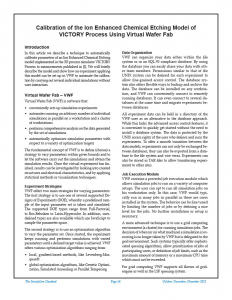Calibration of the Ion Enhanced Chemical Etching Model of VICTORY Process Using Virtual Wafer Fab
In this article we describe a technique to automatically calibrate parameters of an Ion Enhanced Chemical Etching model implemented in the 3D process simulator VICTORY Process to measurements published in [1]. We will briefly describe the model and show how an experiment applying this model can be set up in VWF to automate the calibration by carrying out several individual simulations without user interaction.
Virtual Wafer Fab – VWF
Virtual Wafer Fab (VWF) is software that:
- conveniently sets up simulation experiments
- automates running an arbitrary number of individual simulations in parallel on a workstation and a cluster of workstations
- performs comprehensive analysis on the data generated by the set of simulations
- automatically optimizes simulation parameters with respect to a variety of optimization targets
The fundamental concept of VWF is to define (choose) a strategy to vary parameters within given bounds and to let the software carry out the simulations and obtain the simulation results. Once the virtual experiment has finished, results can be investigated by looking into created structures and electrical characteristics, and by applying statistical methods or visualization techniques.
Experiment Strategies
VWF offers two main strategies for varying parameters. The first strategy is to use one of several supported Designs of Experiments (DOE), whereby a predefined sample of the input parameter set is taken and simulated. The supported DOE types range from Full-Factorial, to Box-Behnken to Latin-Hypercube. In addition, user-defined types are also available which use JavaScript to sample the parameter space.
The second strategy is to use an optimization algorithm to vary the parameter set. Once started, the experiment keeps running and performs simulations with varied parameters until a defined target value is achieved. VWF offers various optimization algorithms ranging from:
- local, gradient-based methods, like Levenberg-Marquardt
- global optimization algorithms, like Genetic Optimization, Simulated Annealing or Parallel Tempering



